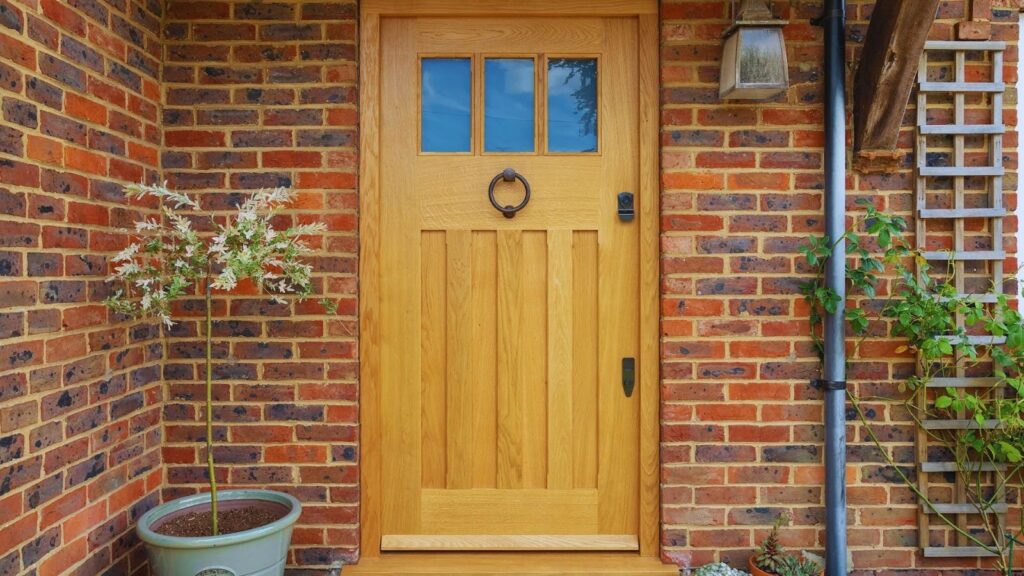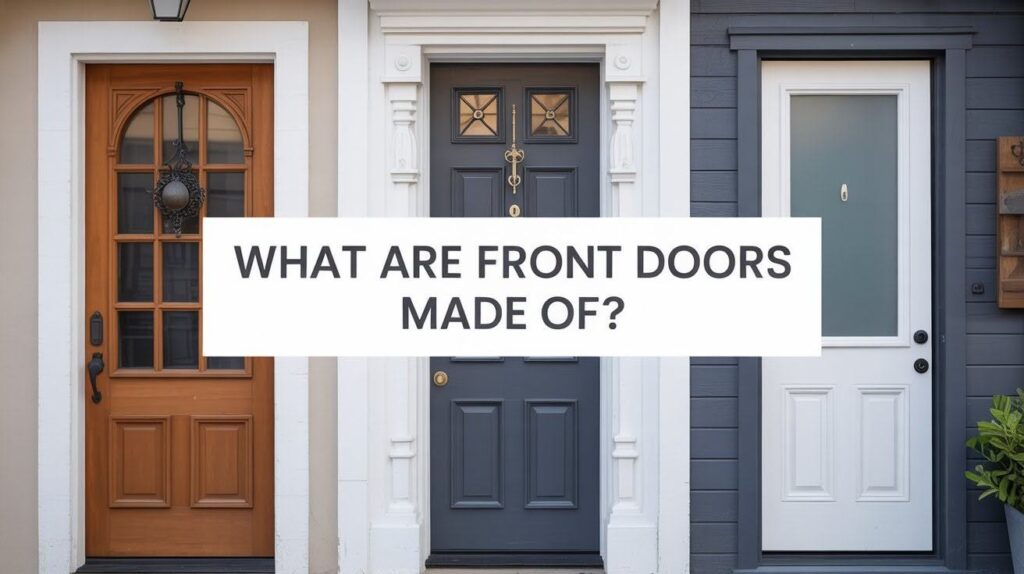Choosing a front door feels confusing when you don’t know where to start. I spent weeks researching materials before replacing mine.
What are front doors made of? Most doors use wood, steel, or fiberglass. Each material handles weather, security, and maintenance differently.
I’ll help you understand which one fits your home, climate, and budget. You’ll learn the real pros and cons of each option. We’ll compare durability, costs, and upkeep needs.
By the end, you’ll know exactly which material works best for your situation.
Let’s find the right door together.
Why Front Door Material Matters

Your front door does more than look good. It protects your home, saves energy, and shapes your first impression. The material you pick affects all these areas for 20 to 30 years.
Security starts at your entrance. A strong door stops break-ins and keeps your family safe. Some materials resist forced entry better than others.
Energy bills add up over time too. Poorly insulated doors let heat escape in winter and cool air leak in summer. The right material cuts your heating and cooling costs significantly.
Maintenance time matters as well. Some doors need yearly refinishing and regular inspections. Others require almost no upkeep beyond basic cleaning.
Your front door also creates the first impression for guests and potential buyers. A worn or dated door hurts your home’s appearance and value.
Understanding these differences helps you make a smart choice. You’ll avoid expensive mistakes and pick a door that truly fits your needs.
Common Materials Used for Front Doors

Front doors come in three main types: natural wood, metal options, and synthetic materials. Each has its own strengths and weaknesses. The right choice depends on how you balance looks, upkeep needs, and insulation.
Some homeowners want traditional warmth and character. Others need modern security and low maintenance. Your door should match your lifestyle and local weather conditions.
Natural wood brings classic beauty but demands regular care. Metal doors offer strong security and energy savings at budget-friendly prices.
Synthetic materials like fiberglass combine the best of both worlds with minimal maintenance requirements. Understanding these differences helps you avoid costly mistakes.
The material you choose affects your home’s curb appeal, energy bills, security level, and how much time you’ll spend on upkeep. Most homeowners replace their front door only once every 20 to 30 years, so getting it right the first time matters.
Types of Front Door Materials
Each material offers unique benefits and challenges that affect your home’s security, energy efficiency, and appearance.
1. Wood Front Doors

Wood doors use solid hardwoods like oak, mahogany, or fir. These materials create a classic, warm look with natural grain patterns. Oak provides strength. Mahogany resists moisture better. Fir costs less but needs more protection.
You can paint wood any color or stain it to show the natural grain. Wood repairs easily since you can sand out scratches and dents. You can refinish the surface multiple times. Solid wood doors feel substantial and reduce outside noise.
Wood needs regular attention though. Moisture causes warping and rotting. Sunlight fades the finish. You’ll need to seal or refinish it every few years. Wood doors cost more upfront and let more heat pass through unless insulated. Termites damage untreated wood. Doors might stick in summer or leave gaps in winter.
2. Steel Front Doors

Steel doors feature galvanized steel sheets wrapped around a foam-insulated core. Modern homes and security-conscious buyers often choose this material. Most come pre-hung for easier installation.
Security ranks highest with steel. These doors resist forced entry and impacts well. They cost less than wood or fiberglass. Maintenance stays minimal since steel handles weather without rotting.
The foam core provides excellent insulation and meets Energy Star requirements. This lowers your heating and cooling costs. Fire resistance offers another advantage, and some insurers give discounts.
Dents happen if something hits the door hard. Rust appears if the finish gets scratched. Design options stay limited. You can paint steel but never stain it. The metal conducts temperature in extreme climates. The smooth surface shows fingerprints and needs regular wiping.
3. Fiberglass Front Doors

Fiberglass doors use molded panels over an insulated frame. Manufacturers texture the surface to look like real wood grain. Many people can’t tell the difference. Today’s products feel solid and look realistic.
Energy efficiency shines with fiberglass. These doors last decades without warping, cracking, or absorbing moisture. You can paint or stain them. Fiberglass never rusts or rots.
Salt air and humidity don’t affect it. This makes it perfect for coastal or humid climates. The lightweight nature makes installation easier and reduces stress on hinges.
Expect higher costs than steel. Quality differs between brands. Cheaper versions look fake or feel hollow. Deep scratches can’t be repaired easily. Some fade with intense sun exposure, so check warranty coverage.
Comparing Front Door Materials
Here’s a side-by-side look at how wood, steel, and fiberglass stack up across key factors.
| Material | Appearance | Durability | Maintenance | Cost | Energy Efficiency |
| Wood | Classic, warm | Moderate | High | $$$ | Medium |
| Steel | Sleek, secure | High | Low | $ | High |
| Fiberglass | Realistic, flexible | Very High | Very Low | $$–$$$ | Very High |
How to Choose the Right Front Door Material
Match the material to your specific needs and circumstances.
- Climate and Weather Exposure: Rain and humidity need rust-resistant materials. Coastal areas benefit from fiberglass. Cold climates require insulated options. South-facing doors face more sun damage. North-facing entries collect moisture.
- Security Needs: Steel provides the strongest protection. Solid wood comes next. Fiberglass offers moderate security. Quality deadbolts and door frames matter too.
- Style and Home Design: Traditional homes suit wood or wood-grain fiberglass. Modern designs work with smooth steel. Match your door to your home’s character.
- Budget Considerations: Steel costs least upfront but limits design. Wood costs most and needs ongoing refinishing. Fiberglass balances initial price with low maintenance.
- Maintenance Commitment: Wood needs regular sealing and refinishing. Steel requires occasional cleaning and touch-ups. Fiberglass needs only basic cleaning. Choose based on your time and skills.
Conclusion
After researching what front doors are made of, I went with fiberglass for my home. My old wood door looked great but demanded constant care. I was tired of refinishing it every summer. Now I enjoy the wood appearance without the hassle.
Wood fits you if you love traditional charm and have time for upkeep. Steel works for tight budgets and maximum security. Fiberglass gives you custom looks with minimal work.
Consider your climate, schedule, and how long you’ll stay. Pick the material that serves you best. What’s your choice?
Frequently Asked Questions
Can you paint all types of front doors?
Yes, all three materials accept paint. Steel requires paint only, while wood and fiberglass work with both paint and stain.
How long does each door material last?
Steel and fiberglass last 30-plus years with minimal care. Wood doors typically need replacement after 15-20 years.
Which door material handles extreme weather best?
Fiberglass performs best in harsh conditions. It resists moisture, warping, and temperature changes better than wood or steel.
Are wood doors worth the extra cost?
Wood adds value to traditional homes where authenticity matters. Most modern homes benefit more from fiberglass at similar prices.
Do insulated doors really save energy?
Yes, insulated steel and fiberglass doors significantly reduce heating and cooling costs throughout the year.

